Tracks Eye Movements With Cameras to Measure What People Read on a Computer Screen
Virtual reality has beginnings that preceded the time that the concept was coined and formalised. In this detailed history of virtual reality we look at how engineering science has evolved and how central pioneers accept paved the path for virtual reality as we know it today.
Defining Virtual Reality
Before we can consider the virtual reality development timeline, we accept to briefly consider that is that counts equally "VR" or should be seen equally a precursor to it. After all, the point of virtual reality is to pull a fast one on someone's brain into believing something is real, even when it isn't.
For example, there's the famous instance of an early on cinematic screening. It showed a train heading straight at the camera. The people in attendance, having never seen moving picture before, had a reaction to the footage as if it were really a train, than just a picture of 1. While that story may be considered more of an urban legend in modern times, it underscores the problem of defining virtual reality neatly. It is entirely possible for motion picture and telly imagery to influence our sense of reality, at least to a point. Nonetheless, we don't think of them and virtual reality as beingness one and the aforementioned.
There are plenty of definitions of VR today, which all more or less overlap in key areas. When we use the word "VR" at present, information technology specifically refers to computer generated imagery and hardware specifically designed to bring those sights and sounds to us in a fashion that is totally immersive.
Many definitions also stipulate that VR must exist interactive. This would differentiate information technology from things like 3D -movies, 360-caste video and other similar "look only don't touch" media. The problem with this is that enough of figurer generated VR isn't interactive at all, withal everyone considers it to be VR. While 360-degree video might non be computer generated, information technology'south functionally no different to a pre-planned non-interactive CG VR experience.
In a historical context then, we have to broaden what is seen as VR or VR-adjacent. Some of the milestones discussed in this commodity are therefore also ancestors to other forms of media, such as movie. The technologies are likewise branched into many unlike directions. In some cases,a milestone is more about the establishment of an idea, rather than the invention f a specific technology.
Early on attempts at virtual reality
Panoramic paintings
If we focus more strictly on the scope of virtual reality equally a means of creating the illusion that nosotros are present somewhere we are not, and so the primeval attempt at virtual reality is surely the 360-degree murals (or panoramic paintings) from the nineteenth century. These paintings were intended to fill the viewer's entire field of vision, making them feel present at some historical event or scene.

1838 – Stereoscopic photos & viewers
In 1838 Charles Wheatstone's research demonstrated that the brain processes the different two-dimensional images from each centre into a unmarried object of iii dimensions. Viewing two side by side stereoscopic images or photos through a stereoscope gave the user a sense of depth and immersion. The later development of the popular View-Master stereoscope (patented 1939), was used for "virtual tourism". The blueprint principles of the Stereoscope is used today for the popular Google Paper-thin and low budget VR head mounted displays for mobile phones.
- 1838 : The stereoscope (Charles Wheatstone)
- 1849 : The lenticular stereoscope (David Brewster)
- 1939 : The View-Primary (William Gruber)
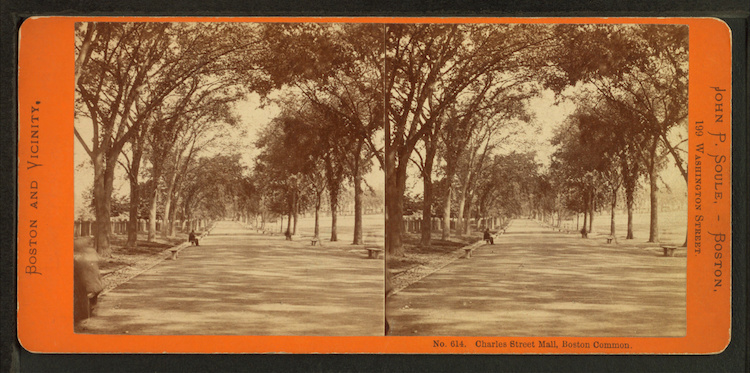
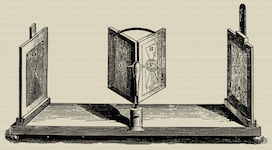
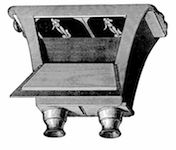
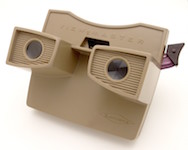
Over time flesh has been slowly but surely creating always richer ways to stimulate our senses. Things actually began to take off in the 20th century, with advent of electronics and calculator technology.
1929 – Link Trainer The First Flight Simulator
In 1929 Edward Link created the "Link trainer" (patented 1931) probably the get-go example of a commercial flight simulator, which was entirely electromechanical. Information technology was controlled by motors that linked to the rudder and steering column to modify the pitch and roll. A small motor-driven device mimicked turbulence and disturbances. Such was the demand for safer ways to train pilots that the US military bought six of these devices for $3500. In 2015 money this was just shy of $50 000. During World War II over 10,000 "bluish box" Link Trainers were used by over 500,000 pilots for initial preparation and improving their skills.
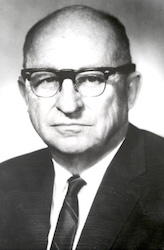
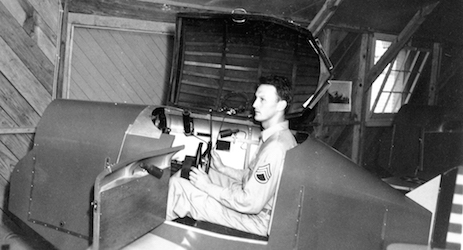
Left: Edward Link, Right: The Link Trainer
1930s – Science fiction story predicted VR
In the 1930s a story by science fiction writer Stanley M. Weinbaum (Pygmalion'due south Spectacles) contains the idea of a pair of goggles that let the wearer experience a fictional earth through holographics, smell, sense of taste and touch. In retrospect the experience Weinbaum describes for those wearing the goggles are uncannily like the modern and emerging feel of virtual reality, making him a true visionary of the field.
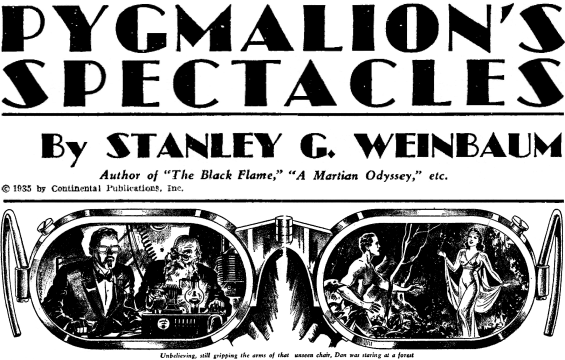 Prototype source: sffaudio.com
Prototype source: sffaudio.com
1950s – Morton Heilig's Sensorama
In the mid 1950s cinematographer Morton Heilig adult the Sensorama (patented 1962) which was an arcade-style theatre cabinet that would stimulate all the senses, not only sight and sound. It featured stereo speakers, a stereoscopic 3D display, fans, smell generators and a vibrating chair. The Sensorama was intended to fully immerse the individual in the film. He also created six curt films for his invention all of which he shot, produced and edited himself. The Sensorama films were titled, Motorcycle, Belly Dancer, Dune Buggy, helicopter, A date with Sabina and I'm a coca cola bottle!
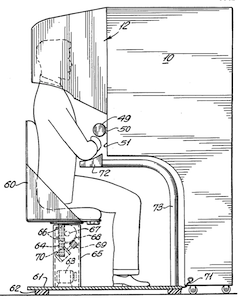

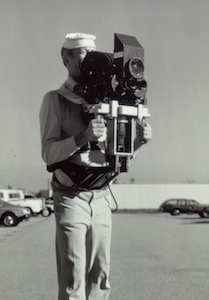
Paradigm source: mortonheilig.com
The video below is an interview with Morton about the Sensorama.
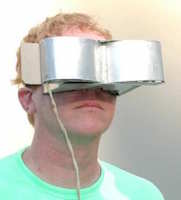
1960 – The first VR Head Mounted Display
Morton Heilig's side by side invention was the Telesphere Mask (patented 1960) and was the offset example of a head-mounted display (HMD), albeit for the non-interactive film medium without any motion tracking. The headset provided stereoscopic 3D and wide vision with stereo sound.
1961 Headsight – First movement tracking HMD
In 1961, two Philco Corporation engineers (Comeau & Bryan) developed the first precursor to the HMD as nosotros know it today – the Headsight. It incorporated a video screen for each eye and a magnetic motion tracking arrangement, which was linked to a closed circuit camera. The Headsight was not actually adult for virtual reality applications (the term didn't exist then), but to allow for immersive remote viewing of dangerous situations by the war machine. Head movements would move a remote camera, assuasive the user to naturally look around the environment. Headsight was the get-go step in the development of the VR head mounted display only information technology lacked the integration of computer and image generation.
1965 – The Ultimate display by Ivan Sutherland
Ivan Sutherland described the "Ultimate Display" concept that could simulate reality to the point where ane could not tell the difference from actual reality. His concept included:
- A virtual world viewed through a HMD and appeared realistic through augmented 3D sound and tactile feedback.
- Figurer hardware to create the virtual word and maintain it in real time.
- The power users to collaborate with objects in the virtual earth in a realistic way
"The ultimate brandish would, of form, be a room within which the computer tin can control the existence of matter. A chair displayed in such a room would exist good enough to sit in. Handcuffs displayed in such a room would be circumscribed, and a bullet displayed in such a room would be fatal. With appropriate programming such a brandish could literally be the Wonderland into which Alice walked." – Ivan Sutherland
This paper would become a core design for the concepts that encompass virtual reality today.
1966 – Furness' Flight Sim
An engineer for the military named Thomas Furness is credited with kick starting the development of modernistic flight simulator technology. Sometimes billed as "the granddad of VR" his work in Man Interface Engineering" continues to inform VR technology to this day.
1968 – Sword of Damocles
In 1968 Ivan Sutherland and his student Bob Sproull created the commencement VR / AR head mounted display (Sword of Damocles) that was continued to a computer and not a camera. Information technology was a large and scary looking contraption that was too heavy for any user to comfortably wear and was suspended from the ceiling (hence its name). The user would besides need to be strapped into the device. The calculator generated graphics were very primitive wireframe rooms and objects.

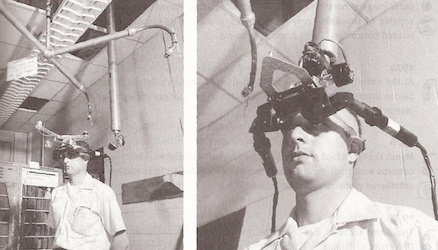
1969 – Bogus Reality
In 1969 Myron Kruegere a virtual reality computer artist developed a series of experiences which he termed "artificial reality" in which he developed computer-generated environments that responded to the people in it. The projects named GLOWFLOW, METAPLAY, and PSYCHIC Space were progressions in his research which ultimately let to the evolution of VIDEOPLACE engineering. This technology enabled people to communicate with each other in a responsive computer generated surround despite being miles autonomously.
1972 – GE Builds a Digital Flight Sim
General Electric produces a "computerized" flight simulator that sports three screens bundled in a 180-degree configuration. The screens surround the simulated training cockpit to requite trainee pilots a feeling of true immersion.
1975 – Krueger's VIDEOPLACE
The VIDEOPLACE is widely regarded every bit the first interactive VR system. Using a mix of CG, lite projection,cameras and screens it could mensurate user position. In modern terms it's more than like an AR projection and didn't characteristic any sort of headset.
1977 – The MIT Picture Map
MIT creates the Aspec Movie Map. This system let people wander through a virtual experience of Aspen, Colorado. It was near like an aboriginal precursor of Google Street View. They used video filmed from a moving machine to create the impression of moving through the city. Once once again, no HMD was part of this setup.
1979 – The McDonnel-Douglas HMD
The VITAL helmet is probably the beginning proper example of a VR HMD outside of the lab. Using a head tracker, pilots could look at primitive computer-generated imagery.
1982 – Sayre Gloves
Finger-tracking gloves for VR chosen "Sayre" gloves are invented by Daniel Sandin and Thomas DeFanti. The gloves were wired to a computer system and used optical sensors to discover finger motion. This was the forerunner to the "data gloves" that would be an important part of early on VR.
1985 – VPL Research is Founded
VR pioneers Jaron Lanier and Thomas Zimmerman establish VPL Inquiry. This is the start ever VR company to sell HMDs and gloves. The term "data glove", comes from their DataGlove production.
1986 – Furness Invents the Super Cockpit
Tom Furness, was the director of an Airforce project known as the "super cockpit". Information technology was a simulator designed for grooming that featured CG graphics and real time interactivity for pilots. Interestingly, the Super Cockpit featured integration between movement tracking and aircraft control.
1987 – Virtual reality the name was born
Even after all of this evolution in virtual reality, at that place still wasn't an all-encompassing term to describe the field. This all inverse in 1987 when Jaron Lanier, founder of the visual programming lab (VPL), coined (or according to some popularised) the term "virtual reality". The research area at present had a name. Through his company VPL research Jaron developed a range of virtual reality gear including the Dataglove (along with Tom Zimmerman) and the EyePhone head mounted display. They were the first company to sell Virtual Reality goggles (EyePhone one $9400; EyePhone HRX $49,000) and gloves ($9000). A major development in the surface area of virtual reality haptics.
1989 – NASA Gets Into VR
NASA, with the help of a Crystal River Engineering, creates Project VIEW. A VR sim used to train astronauts. VIEW looks recognizable equally a modern example of VR and features gloves for fine simulation of touch interaction. Interestingly, the technology in these gloves leads straight to the creation of the Nintendo Power Glove.

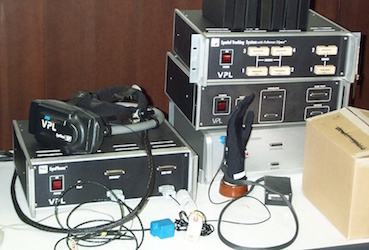
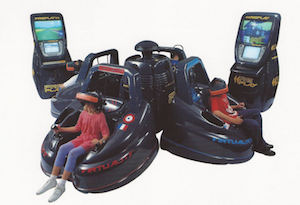
1991 – Virtuality Group Arcade Machines
We began to come across virtual reality devices to which the public had access, although household ownership of cut edge virtual reality was still far out of attain. The Virtuality Grouping launched a range of arcade games and machines. Players would clothing a set of VR goggles and play on gaming machines with realtime (less than 50ms latency) immersive stereoscopic 3D visuals. Some units were also networked together for a multi-histrion gaming experience.
1991 – Medina's VR Mars Rover
These days we are pretty used to seeing alive footage from Mars rovers. Back in 1991 this was still a futurity dream and there were many problems left to solve. A NASA engineer named Antonio Medina develops a VR system that lets you pilot a Mars rover, even taking the time filibuster into account. A system dubbed "Computer Simulated Teleoperation".
1992 – The Lawnmower Human
The Lawnmower Human movie introduced the concept of virtual reality to a wider audition. It was in role based on the founder of Virtual Reality Jaron Lanier and his early on laboratory days. Jaron was played by Pierce Brosnan, a scientist who used virtual reality therapy on a mentally disabled patient. Real virtual reality equipment from VPL inquiry labs was used in the film and the director Brett Leonard, admited to drawing inspiration from companies like VPL.
1993 – SEGA announce new VR glasses
Sega appear the Sega VR headset for the Sega Genesis console in 1993 at the Consumer Electronics Show in 1993. The wrap-around protoype glasses had head tracking, stereo sound and LCD screens in the visor. Sega fully intended to release the product at a price betoken of most $200 at the time, or about $322 in 2015 money. Even so, technical development difficulties meant that the device would forever remain in the prototype phase despite having developed 4 games for this product. This was a huge flop for Sega.
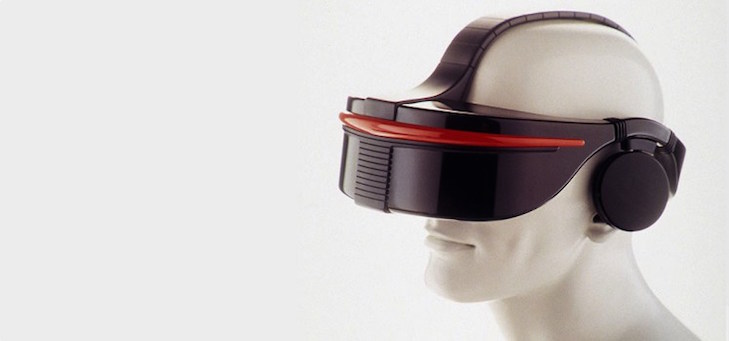
1994 – The Sega VR-1
On a roll with their VR devices, Sega also releases it's VR-1, an arcade motility simulator that moves in accordance to what's happening on-screen. This makes it like the As-i, but the VR uses a head-mounted brandish, whereas the As-1 fabricated use of a regular project screen.
1995 – Nintendo Virtual Boy
The Nintendo Virtual Boy (originally known as VR-32) was a 3D gaming panel that was hyped to exist the outset ever portable panel that could display true 3D graphics. It was start released in Japan and North America at a price of $180 simply it was a commercial failure despite price drops. The reported reasons for this failure were a lack of colour in graphics (games were in red and black), there was a lack of software support and information technology was difficult to employ the console in a comfy position. The post-obit twelvemonth they discontinued its production and auction.
1997 – Landmark VR PTSD Treatment
Georgia Tech and Emory University collaborate to use VR for the treatment of PTSD in war veterans. This is nonetheless a crucial attribute of PTSD treatment and research today. Controlled exposure to traumatic triggers are crucial to treating the symptoms of PTSD. VR applied science gave therapists unrivaled command over what the patients sees and experiences.
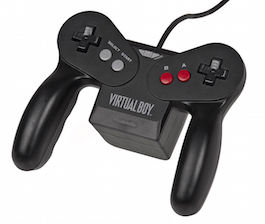
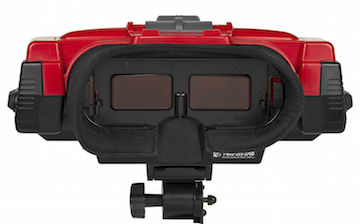
1999 – The Matrix
In 1999 the Wachowski siblings' film The Matrix hits theatres. The film features characters that are living in a fully faux world, with many completely unaware that they do non alive in the real globe. Although some previous films had dabbled in depicting virtual reality, such equally Tron in 1982 and Lawnmower Man in 1992, The Matrix has a major cultural affect and brought the topic of simulated reality into the mainstream.
2007 – Google Brings Us Street View
Google enhanced its Maps service with street-level 360-caste images, captured by special cars fitted with custom camera equipment. Immersive Media did the work using a dodecahedral photographic camera of their own pattern. Today you can "stand" in just about any part of the globe and await effectually thanks to this technology.
2010 – Street View Goes 3D and the Oculus is Prototyped
Just a few years later, Street View gets a 3D mode, just much bigger news in the history of VR is the piece of work existence done by a young man known every bit Palmer Lucky. He'due south created a kit VR headset that anyone can make, simply a fateful meeting with computer legend John Carmack puts him on the path to taking his "Oculus Rift" bigger than he could have imagined.
2012 – The Oculus Kickstarter
Palmer Lucky launches a Kickstarter to fund the product and development of his prototype headset, the Rift. The campaign raises nigh 2.five million dollars and is a clear dividing line between the commercial failures of consumer VR in the past and the mod VR revolution.
2014 – Facebook Buys Oculus and Sony Announced their VR Project
Social media giant sees potential in the Oculus technology, buying the company and making Lucky incredibly wealthy. This is a bumper yr, as well seeing the launch of Google Paper-thin, PSVR and the Samsung Gear VR. Virtual Reality is suddenly a very hot topic.
This is besides the twelvemonth that Sony announced that they are working on a VR add-on for the pop PS4 console. The PS4 is much less powerful than VR-capable computers of the twenty-four hour period, and so everyone is pretty curious to run across how they'll pull information technology off.
2016–2017 – All Hell Breaks Loose
This is the year everyone unleashes VR products that are ready for primetime. The Rift and the HTC Vive lead the manner, only the floodgates have truly opened. You can see the results of this boom by visiting our HMD database .
2018 – The Half-dome HMD is Announced
Oculus shows off a new HMD prototype known as the "half dome". This advanced headset uses varifocal lenses and an extremely wide field of view, at 140 degrees.
2018 – Standalone VR Rises, Mobile VR Dies
We now have both the Oculus Get and Oculus Quest. Two examples of standalone VR, that need no computer or phone to work. Mobile VR is failing rapidly and standalone systems such every bit the Become are very affordable.
2019 – VR is Shifting Rapidly
Mixed Reality systems and sophisticated technologies are now part of standalone VR headsets. The Oculus Quest receives a promise of tethering capability and smartphone-based VR projects begin shutting down.
The cost of VR headsets has dropped dramatically and reckoner hardware capable of running these headsets is near mainstream. Many avant-garde headsets are on the horizon. Varifocal technology, extremely wide fields of view, hand scanning and eye tracking are but a few of the key developments.
Major companies such as Apple are rumoured to be working on mixed reality projects and at this point information technology fourth dimension information technology seems equally if VR and mixed reality are likely to be inseparable in time to come.
rogerswittleen1945.blogspot.com
Source: https://www.vrs.org.uk/virtual-reality/history.html
ارسال یک نظر for "Tracks Eye Movements With Cameras to Measure What People Read on a Computer Screen"